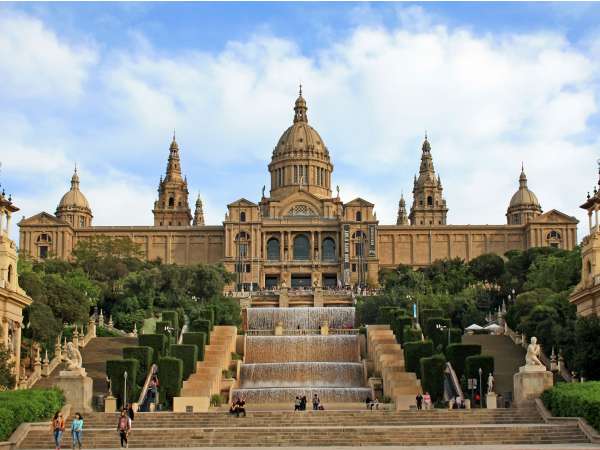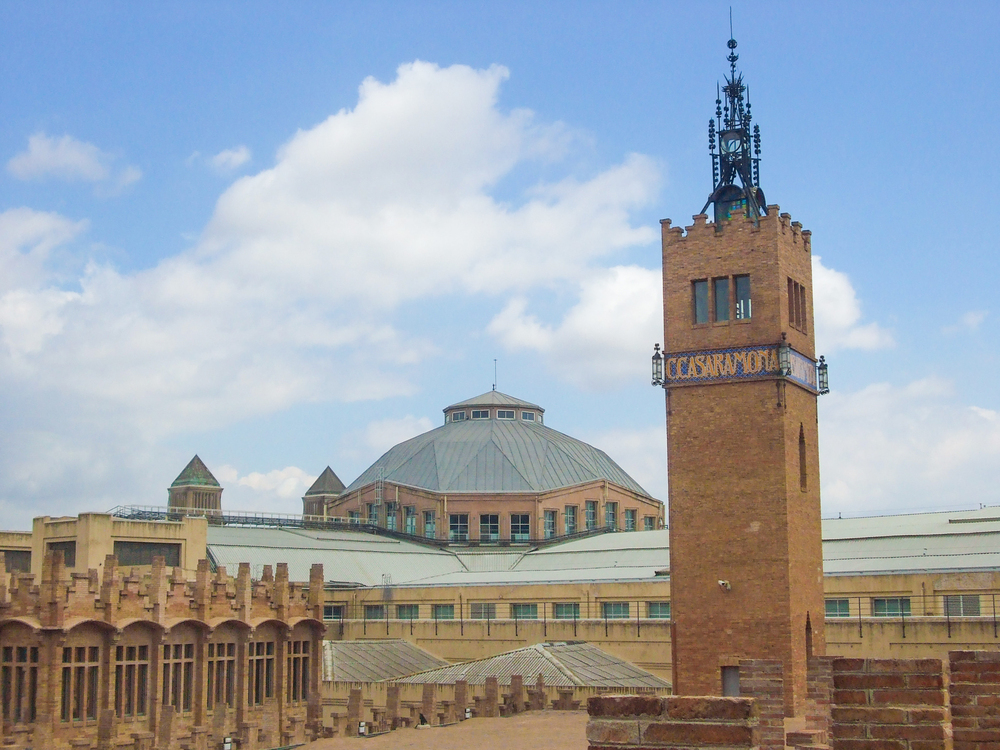A tour through the history of the National Palace
Located on the hill of Montjuïc, the National Palace of Barcelona, known as Palau Nacional, is one of the most emblematic architectural and cultural treasures of the city. This impressive Renaissance building not only captures the attention not only for its architectural grandeur, but also for the rich history housed within its walls.
Built between 1926 and 1929 as the epicenter of the 1929 International Exposition, this palace represents the innovative and cultural spirit of Barcelona. Since 1934, it has been the home of the National Art Museum of Catalonia (MNAC), home to an enviable collection of Romanesque art.
Conceived by architects Eugenio Cendoya and Enric Catà, and supervised by Pere Domènech i Roura, the building combines classical architecture that towers over the city, inviting visitors to an immersive experience in Catalan culture and art. Each corner of the Palau Nacional reflects a historical moment, a piece of Barcelona’s identity and its evolution as a cultural center. Today, it is the scene of exhibitions, concerts and events that enrich the social and cultural life of the city, being an obligatory stop for tourists and locals alike.
Location and how to get there
The privileged location of the National Palace, atop the hill of Montjuïc, offers unparalleled panoramic views of Barcelona. From the viewpoint of the Palau Nacional, visitors can see not only the city, but also highlights such as Montjuïc Castle and the Magic Fountain. To reach the palace, you can use several bus lines, a funicular that connects to the city center and even a cable car from the port of Barcelona, an option that provides spectacular views of the Mediterranean and the city skyline.
The walk to the Palau is an experience in itself, as it allows you to enjoy a unique natural and cultural environment in the city. Once at the palace, visitors can tour the MNAC and admire its outstanding collection of Romanesque art, one of the most complete in the world, or simply relax in the gardens surrounding the building.
The architectural majesty of the Palau Nacional
The National Palace is a colossal building, with an approximate surface of 32,000 square meters and a rectangular structure flanked by two lateral bodies. Its classicist and Renaissance design has a central dome supported by 16 stone columns, a true architectural feat. Visitors marvel at the noucentista-style interior decoration, created by some of the most outstanding artists of the time.
The palace’s terrace and rooftop terrace, which are open to the public, are points of interest that offer an unparalleled view of Barcelona and its surroundings. The combination of these spaces with the monumentality of the structure makes the National Palace an essential stop for those who wish to immerse themselves in the history and beauty of the city.
The collection of the National Museum of Art of Catalonia
The MNAC, located inside the Palau Nacional, is famous for housing one of the most important collections of Romanesque art in the world. This collection includes murals and sacred art that transport visitors to distant times, showing the cultural and artistic depth of Catalonia. In addition to Romanesque art, the museum features Gothic, Renaissance and Baroque art, as well as modern art and photography, offering a visual experience that spans centuries of history and creativity. For art lovers, the MNAC is a must-see, allowing visitors to discover everything from medieval paintings to 20th-century works, providing a complete perspective of the evolution of art in Catalonia and Europe. Access to this collection is an opportunity to explore and understand Barcelona’s role as an international cultural hub.
Useful information for planning your visit
If you plan to visit the National Palace and the MNAC, it is useful to keep in mind some practical details. The museum is open from Tuesday to Saturday from 10:00 am to 7:00 pm and on Sundays and holidays from 10:00 am to 2:30 pm, which allows you to organize a comfortable visit. The entrance fee is approximately €8.50, although it may be subject to change.
For those looking for a more complete experience, the museum organizes temporary exhibitions and special events throughout the year, adding a touch of dynamism to its cultural offerings. The visit can be complemented with a tour of the gardens and terraces of the Palau Nacional, which offer an ideal space to relax and enjoy nature in the middle of the city.
Curiosities about the National Palace and its surroundings
The National Palace is not only an art museum, but also a space full of history and anecdotes. For example, the palace was inaugurated by King Alfonso XIII and his wife, who emphasized the importance of the building as a cultural symbol. Since then, it has witnessed numerous events and has housed pieces of art of great value. Another interesting fact is that the hill of Montjuïc, where the palace is located, has traditionally been a strategic point in Barcelona, and in addition to housing the MNAC, it has other attractions such as the Montjuïc Castle and the Botanical Garden. This setting makes a visit to the National Palace a multifaceted experience, where art, history and nature merge to offer a unique perspective of the city.
A symbol of Catalan culture
The National Palace of Montjuïc, with its impressive architecture and art collection, represents a symbol of pride for the inhabitants of Barcelona and an emblem of Catalan culture. Through its exhibitions, the MNAC celebrates the artistic legacy of the region, from Romanesque frescoes to Gothic sculptures and Renaissance paintings. For visitors, the Palau Nacional is not just a building, but a gateway to the history and roots of Catalonia.
A must-see in Barcelona
To visit the National Palace of Montjuïc is to immerse oneself in the cultural heart of Barcelona. From its roots in the 1929 International Exposition to its current role as the home of the MNAC, the palace is a symbol of the city’s rich artistic heritage. Its location, architecture and art collection make it an unmissable destination for those who want to get to know the cultural essence of Barcelona.
Don’t miss the opportunity to explore the Palau Nacional and immerse yourself in the beauty and history that this iconic site has to offer. Beyond being a museum, it is a place where the art and history of Catalonia is celebrated, inviting every visitor to be part of this fascinating cultural narrative.




